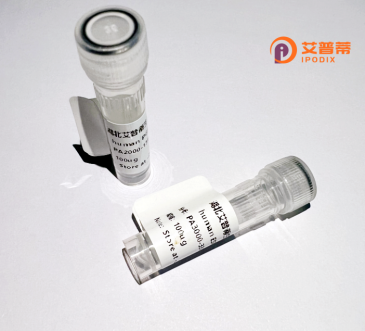
| 纯度 | >90%SDS-PAGE. |
| 种属 | Human |
| 靶点 | SOX10 |
| Uniprot No | P56693 |
| 内毒素 | < 0.01EU/μg |
| 表达宿主 | E.coli |
| 表达区间 | 1-466 aa |
| 活性数据 | MAEEQDLSEV ELSPVGSEEP RCLSPGSAPS LGPDGGGGGS GLRASPGPGE LGKVKKEQQD GEADDDKFPV CIREAVSQVL SGYDWTLVPM PVRVNGASKS KPHVKRPMNA FMVWAQAARR KLADQYPHLH NAELSKTLGK LWRLLNESDK RPFIEEAERL RMQHKKDHPD YKYQPRRRKN GKAAQGEAEC PGGEAEQGGT AAIQAHYKSA HLDHRHPGEG SPMSDGNPEH PSGQSHGPPT PPTTPKTELQ SGKADPKRDG RSMGEGGKPH IDFGNVDIGE ISHEVMSNME TFDVAELDQY LPPNGHPGHV SSYSAAGYGL GSALAVASGH SAWISKPPGV ALPTVSPPGV DAKAQVKTET AGPQGPPHYT DQPSTSQIAY TSLSLPHYGS AFPSISRPQF DYSDHQPSGP YYGHSGQASG LYSAFSYMGP SQRPLYTAIS DPSPSGPQSH SPTHWEQPVY TTLSRP |
| 分子量 | 49.9 kDa |
| 蛋白标签 | His tag N-Terminus |
| 缓冲液 | PBS, pH7.4, containing 0.01% SKL, 1mM DTT, 5% Trehalose and Proclin300. |
| 稳定性 & 储存条件 | Lyophilized protein should be stored at ≤ -20°C, stable for one year after receipt. Reconstituted protein solution can be stored at 2-8°C for 2-7 days. Aliquots of reconstituted samples are stable at ≤ -20°C for 3 months. |
| 复溶 | Always centrifuge tubes before opening.Do not mix by vortex or pipetting. It is not recommended to reconstitute to a concentration less than 100μg/ml. Dissolve the lyophilized protein in distilled water. Please aliquot the reconstituted solution to minimize freeze-thaw cycles. |
以下是关于重组人SOX10蛋白的3篇代表性文献及其摘要概述:
1. **文献名称**:*SOX10 regulates an alternative promoter activity linking melanoma specific gene expression*
**作者**:Shakhova O. et al.
**摘要**:研究揭示了SOX10在黑色素瘤中通过调控特定启动子驱动肿瘤相关基因表达的机制,重组SOX10蛋白被用于染色质免疫沉淀(ChIP)实验,证实其直接结合靶基因启动子区。
2. **文献名称**:*Recombinant human SOX10 protein purification and DNA-binding analysis*
**作者**:Pingault V. et al.
**摘要**:该文献描述了重组人SOX10蛋白在大肠杆菌中的表达与纯化方法,并利用凝胶迁移实验(EMSA)验证其与DNA顺式作用元件的特异性结合能力,为后续功能研究提供了工具。
3. **文献名称**:*SOX10 mutations in human peripheral neuropathies: functional studies using recombinant proteins*
**作者**:Inoue K. et al.
**摘要**:通过体外表达携带疾病突变(如CMT4E)的重组SOX10蛋白,发现突变会破坏其转录激活能力,导致施万细胞发育异常,为周围神经病变的分子机制提供了证据。
---
*注:若需获取全文或更多文献,建议通过PubMed(https://pubmed.ncbi.nlm.nih.gov/)输入关键词“SOX10 recombinant protein”检索,并结合筛选条件(如研究领域、发表年份)进一步缩小范围。*
SOX10 (SRY-related HMG-box 10) is a transcription factor belonging to the SOX protein family, characterized by a conserved high-mobility group (HMG) DNA-binding domain. It plays a critical role in the development and differentiation of neural crest-derived cells, including Schwann cells, melanocytes, and enteric ganglia. During embryogenesis, SOX10 regulates the expression of target genes involved in cell fate determination, migration, and survival, notably influencing the formation of the peripheral nervous system and pigmentation. Mutations in the SOX10 gene are linked to neurocristopathies such as Waardenburg syndrome type IV (WS4) and Hirschsprung’s disease, underscoring its essential role in neural crest biology.
Recombinant human SOX10 protein is produced via genetic engineering in host systems (e.g., E. coli or mammalian cells), enabling studies of its structure, function, and interactions. This purified protein retains DNA-binding activity and is widely used in in vitro assays, including electrophoretic mobility shift assays (EMSAs), chromatin immunoprecipitation (ChIP), and cell culture experiments to investigate transcriptional regulation. Researchers also employ it to model SOX10-related diseases, screen therapeutic compounds, or develop diagnostic tools. Its application extends to cancer research, as SOX10 is a biomarker in melanoma and certain nerve sheath tumors. By providing a controlled, bioactive form of the protein, recombinant SOX10 facilitates mechanistic insights into developmental pathways and disease mechanisms.
×